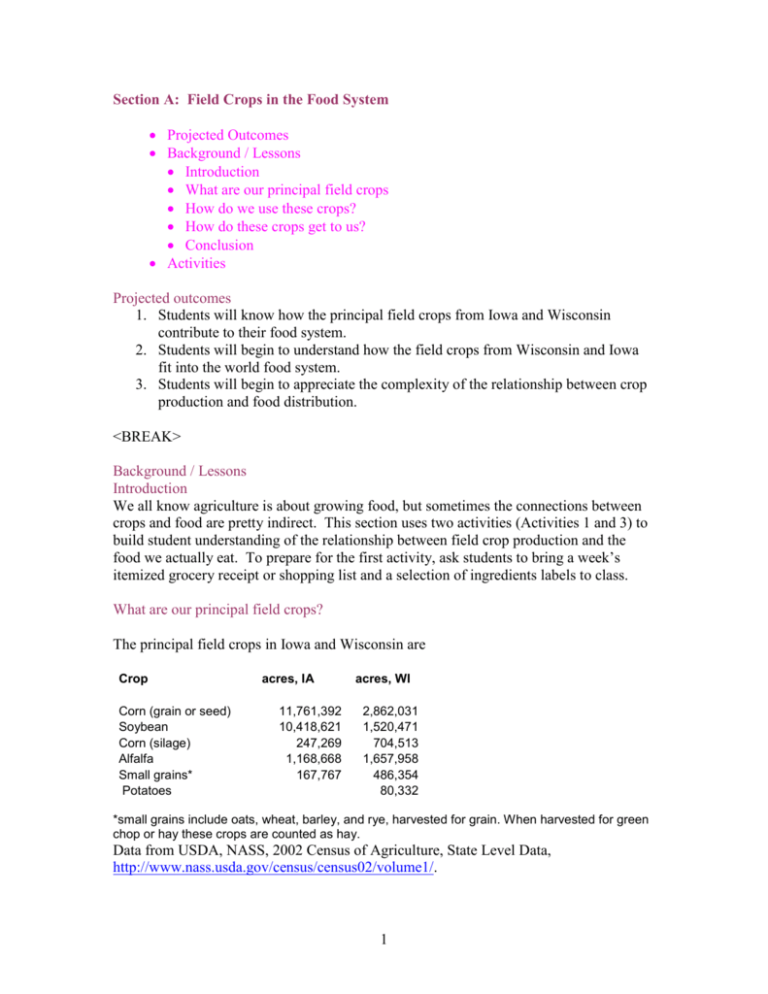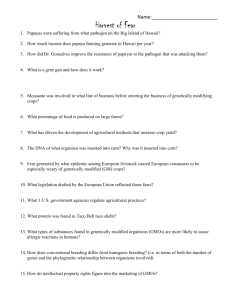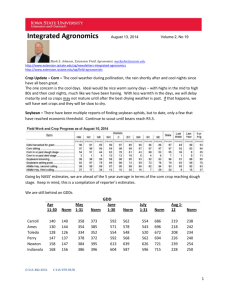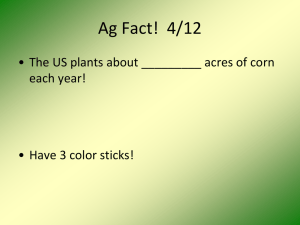Module 2: Sustainable Field Cropping Systems
advertisement

Section A: Field Crops in the Food System Projected Outcomes Background / Lessons Introduction What are our principal field crops How do we use these crops? How do these crops get to us? Conclusion Activities Projected outcomes 1. Students will know how the principal field crops from Iowa and Wisconsin contribute to their food system. 2. Students will begin to understand how the field crops from Wisconsin and Iowa fit into the world food system. 3. Students will begin to appreciate the complexity of the relationship between crop production and food distribution. <BREAK> Background / Lessons Introduction We all know agriculture is about growing food, but sometimes the connections between crops and food are pretty indirect. This section uses two activities (Activities 1 and 3) to build student understanding of the relationship between field crop production and the food we actually eat. To prepare for the first activity, ask students to bring a week’s itemized grocery receipt or shopping list and a selection of ingredients labels to class. What are our principal field crops? The principal field crops in Iowa and Wisconsin are Crop Corn (grain or seed) Soybean Corn (silage) Alfalfa Small grains* Potatoes acres, IA 11,761,392 10,418,621 247,269 1,168,668 167,767 acres, WI 2,862,031 1,520,471 704,513 1,657,958 486,354 80,332 *small grains include oats, wheat, barley, and rye, harvested for grain. When harvested for green chop or hay these crops are counted as hay. Data from USDA, NASS, 2002 Census of Agriculture, State Level Data, http://www.nass.usda.gov/census/census02/volume1/. 1 More than half of the cropland in Iowa and Wisconsin is in field crop production. 63% of Wisconsin’s cropland and 87% of Iowa’s cropland is planted to just 3 crops: corn, alfalfa, and soybeans. How are these crops used? Where do they go? <BREAK> How Do We Use These Crops? Activity 1: The Crops on Our Plates Corn: All the silage corn is used to feed livestock, primarily dairy cows. Most grain corn also goes to feed livestock. In 2002, American farmers harvested 9 billion bushels of corn. Iowa produced 22% of the U.S. corn crop - almost 2 billion bushels. About 75% goes to feed livestock in the US and other countries, 8% goes to fuel ethanol, and more than 6% goes to sweeteners. (These statistics vary a little, depending on the year and how the reporting organization breaks them down, but the general proportions remain similar.) 2002 U.S. Corn Use by Segment From Iowa Corn Growers Assoc. website http://www.iowacorn.org/consumption.htm Activity 2: How much corn is 2 billion bushels (Iowa’s corn harvest)? About 21 to 24 percent of grain corn in the US is exported. Most corn exports are used to feed livestock. Japan is the leading importer of US corn, followed by Mexico, Taiwan, and Egypt.. (Japan currently takes about 30% of our corn exports, and Mexico, Taiwan, and Egypt combined another 30%) (Corn export markets have been hurt in recent years, because key export markets, including Japan and Europe do not want to buy genetically 2 modified grains.) (According to American Corn Growers Association, ca. 80% of corn grown in US is used to feed livestock worldwide) About 20 percent of grain corn is used for seed, industrial uses, and food. The major industrial use is for ethanol production (about 10% of the total grain crop).. The main food use is for sweetener (for example in soft drinks, jams and jellies, and a wide range of processed foods). http://www.corn.org/web/foodseed.htm Less than 5% of the US grain corn crop goes to human food other than sweetener. Soybeans: 59% of harvest crushed for oil, (residue, called soy meal, is fed to livestock). Oil goes primarily (more than 90%) to edible uses (shortening in baked goods, frying oils, salad oils, margarine, coffee creamers, mayonnaise, etc.) and accounts for about 80% of the vegetable oil used in the US. The rest goes to industrial uses (diesel fuels, inks, pesticides, soaps, shampoos, and detergents, etc.) see table in 2003 Soya and oilseed bluebook, p. 384. from http://www.soystats.com/2003/Default-frames.htm 36% of harvest exported (some used for oil & livestock feed; some for human food, esp. in Asia) 6% of harvest used in US for seed, feed, human food other than oil, and industrial uses. Human food examples: soymilk, tofu, roasted soy nuts, infant formula, soy sauce, edamame. Standard high yield soybean varieties are not suitable for many non-oil human food usues. Alfalfa: Virtually all of the alfalfa (and other hay) is used to feed livestock, primarily cows (both beef and dairy). <BREAK> How Do These Crops Get to Us? Activity 3: A Look at Processing and Distribution Flowchart for a Soft Drink. One of the main ingredients in carbonated soft drinks is high fructose corn syrup (HFCS). What are the steps between the corn growing in the field and the can of soda on the grocery store shelf? Let’s look at one example can of soda. Cub Foods, a grocery store in Madison, Wisconsin gets its Coca Cola products from a local distributor in Madison. 3 The distributor in turn picks up the bottled and canned soda from the Coca Cola Bottling Company of Wisconsin, located in Milwaukee, Wisconsin. The Bottling Company combines water, CO2, flavorings, and high fructose corn syrup to make the drink and packages it in bottles and cans. They obtain the high fructose corn syrup by the truckload ??? from Archer Daniels Midland (ADM), a major grain handling and processing company. ADM is headquartered in Decatur, Illinois, but the HFCS used in the Milwaukee bottling plant comes from ???? Jodi, this flowchart is not yet complete. Do you want to add it to the website later, or do you want to hold off putting the whole thing on until the flow chart is done? <BREAK> Conclusion Field crops play a major role in our agricultural system. Just three species, corn, soybeans, and alfalfa, account for well over half the cropland in Wisconsin and Iowa. The primary use of these crops is for livestock feed. Other uses include fuels and industrial ingredients, and oils, sweeteners, and stabilizers for processed foods. The portion of the field crop harvest that goes to human food is mostly heavily processed. Most consumers know little about what activities and companies are involved in the production of the processed foods they buy, and that information is not easily accessible. Because field crops are so dominant, the ways they are raised, handled, and marketed will have a major impact on the sustainability of our agricultural environment and economy as well as our food system. Section B of this module provides case studies of sustainable field crop production. Sections C and D cover the ecology and economics of field crop production. Section E addresses the controversy surrounding the use of transgenic field crops. 4






